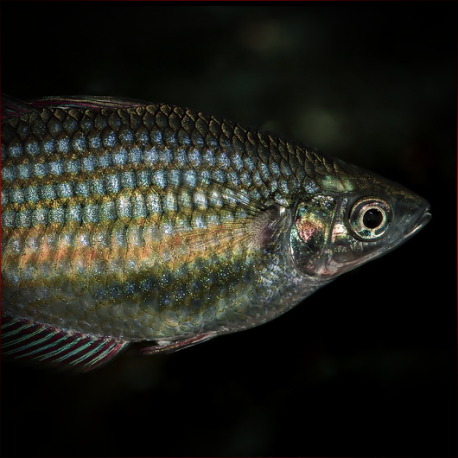More info
Datasheet
| Minimum Tank Size | 110 litres / 29.06 US gallons |
| Maximum Size | 15.0cm / 5.91inches |
| Temperature | 20°C / 68.00°F - 30°C / 86.00°F |
| Hardness | 5-20ºdH |
| pH | 5.0-8.0 |
General Description
The Eastern Rainbowfish, scientifically known as Melanotaenia Splendida Splendida, is a species with four described subspecies distinguished by variations in color, pattern, and fin counts. These fish exhibit a wide array of colors and patterning depending on their locality, with adults displaying stunning hues compared to the more drab juveniles.
Aquarium Setup
The Eastern Rainbowfish thrives in a planted aquarium setup with dense vegetation and open swimming spaces. Water movement should be slow to moderate, although live plants generally prefer minimal disturbance. A tank size of at least 110 liters is recommended for a group of 6-8 or more of these skittish rainbowfish.
Behaviour
Known for their peaceful demeanor, Eastern Rainbowfish can be disruptive to smaller or slower tankmates due to their rapid movements and relatively large size. They do best when kept in shoals, where males will showcase their vibrant colors when in the company of their own kind. Suitable tankmates include similarly-sized rainbowfish, characins, danios, and catfish like Corydoras.
Feeding and Diet
These rainbowfish have an unfussy diet, accepting various dried, frozen, and live foods. Regular feedings of live foods contribute to their best coloration. Offering a diverse diet ensures their nutritional needs are met, enhancing their overall health.
Reproduction & Dimorphism
Breeding Eastern Rainbowfish is relatively straightforward, with the species being egg scatterers. Males exhibit brighter coloration and larger size than females, developing longer dorsal and anal fins. Selecting the optimal pair for breeding and providing suitable conditions in a separate breeding tank are essential for successful reproduction.
Habitat and Distribution
Native to Australia, Eastern Rainbowfish inhabit a range of environments, including swamps, lagoons, streams, and rivers subject to seasonal temperature and water level changes. These fish are commonly found sheltering under aquatic vegetation or debris, such as submerged logs.

